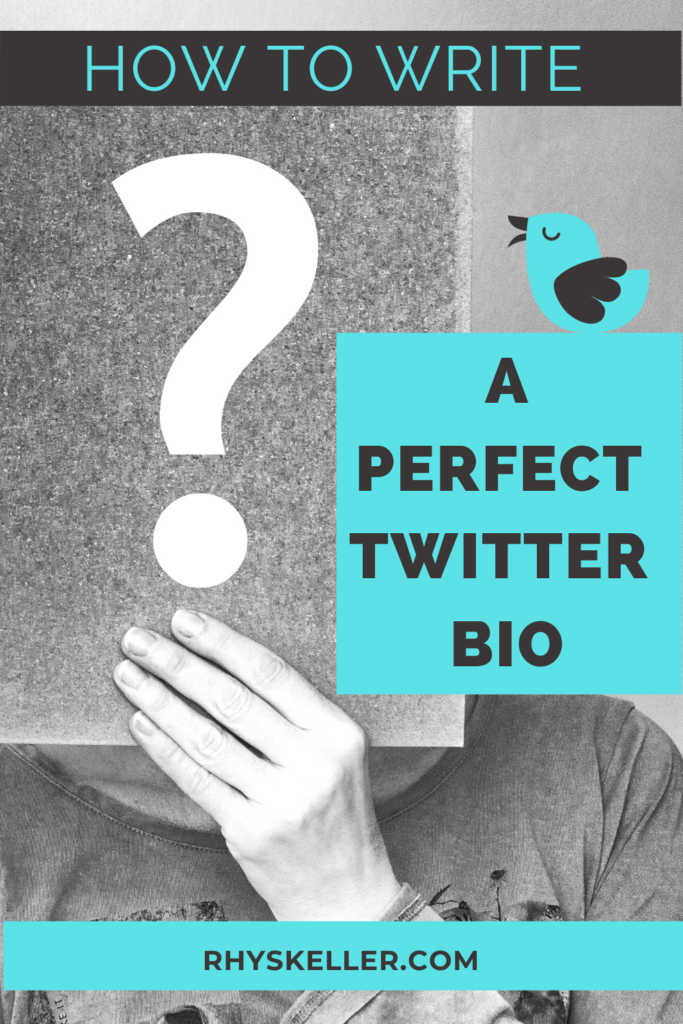One of the biggest complaints I hear from writers is writing the perfect twitter bio. Most would settle for just a decent bio! Even authors who have published books struggle when it comes to boiling down their life to 160 characters. So, I did some research for you from my 12,000 Twitter followers to bring you the best tips in crafting a Twitter bio you’ll be proud of.
When you buy through my links, I may earn money from my affiliate partners. Learn more.
What is a Twitter Bio
Twitter is one of the many social media platforms available today.
Other platforms you are likely familiar with are Facebook, Pinterest, YouTube, and Instagram.
Each social media platform provides people with the ability to create a profile of themselves in order to connect with others.
Each platform has a space to provide a biography (bio) of yourself with rules.
Twitter’s rules for your bio are simple.
Don’t write more than 160 characters.
You can use special characters like asterisks * and ampersands &, or provide email and website links. You can use hashtags like #DadLife or even mention people like @Rhys_Keller.
This blank slate and maximum character limit is what trips so many people up.
How in the world can you express who you are, what you’re all about, and what people can expect from you in so little space?
It’s an easier answer than you think.
I researched some of my 12,000 followers when I wrote this article and noticed a pattern.
It all comes down to what format or style you like, how many followers you have, and who your intended target audience is.
The 3 Twitter Bio Formats
There are predominantly three Twitter bio formats and styles:
- Keywords and locators
- Narrative and identifiers
- Purpose or passion
Keywords and Locators Twitter Format
This is my current favorite bio style.
Keywords are categories or interests that explain what you’re interested in.
People who share your interests are more likely to connect or engage with you because of the shared commonality.
Keywords are things like Engineer, Writer, Author, Illustrator, Basketball Player, Pro Footballer, Musician, Dad, Librarian, etc.
Locators are mentions (using the at symbol @) or hashtags (using the hash symbol #) to help people find and connect with you.
These could be things like #WritingCommunity, #DadLife, #art, #success, #kidlit, #motivation, etc.
For someone seeking to build new connections and grow their followers, this style of Twitter bio is very effective. Here’s my keyword and locators bio (as of today writing this post!):
@Rhys_Keller
Author | Pro Engineer | Startup Founder/Advisor | Christ Follower | #writerslife #kidlit #dadlife #childrensbooks #writingcommunity #bloggerstribe #writerlift
Notice in my Twitter bio that I’ve captured keyword ideas to build commonality and trust in the community.
As an author, I’m eager to connect with people in the book and publishing space.
As a Professional Engineer, it’s clear I’m interested in methods and practices that help society.
My background and passion for business helps other business owners or those considering starting their own company to connect with me and trade ideas.
And I express I’m a Christ Follower to share my faith and connect with others spiritually.
My Twitter bio also includes a variety of locator hashtags.
Because I often Tweet in these hashtag areas, I will often appear in the categories for people I’m not connected with yet.
This allows people to find me and me find more people to build our ever growing connections.
Each keyword and identifer helps communicate to others what I am all about.
It’s not the end-all be-all, but it surely gives a strong foundation. As you seek to build your Twitter community of followers and choose who you follow, you can see how helpful it is to know what you can expect from someone.
On this point, I can’t stress enough how important it is to be respectful and clean on social media.
Time and time again people who use foul language or disrespect others are muted, blocked, or reported.
I know you’re not that person so this is just a reminder that good, clean Twitter bios build the best followers.
Famous singer Josh Groban @joshgroban at the time of this writing has a keyword bio that says: Professional Scribbler, Warbler, and Ivory Tickler
Narrative and Identifiers Twitter Format
Writing a narrative with identifiers in a Twitter bio is one of the most common I’ve seen.
This style of biography is almost a paragraph in nature, with some exceptions due to the obvious character limit.
Remember, grammar rules don’t always apply to social media because of character limits!
If you choose a narrative bio, you’ll typically write in first person (I’m an author, engineer, and coffee fiend working on my debut children’s book. I’ve been blogging forever and interview neat people.) or third person (Rhys Keller is an author and engineer working on one of many picture book WIPs. He stays busy blogging and interviewing awesome people).
The narrative style is easy to read and helpful to communicate who you are and what you’re all about.
However, trying to force grammatical structure through sentences is going to reduce your ability to communicate effectively.
You won’t be able to write everything you want since so many filler words or punctuation is used.
Identifiers are companies, other people, or links that reinforce your narrative.
For example, if I’m a Target employee, I may add @Target to my bio.
If I’m represented by a literary agent, I may add their name or the agency to my bio with an @ mention.
Other identifiers could be an email address, website, company website, blog site, or YouTube account.
Naturally, identifiers eat up precious character limits so choose them wisely and consider if it’s really necessary.
Famous tennis player Andy Murray @andy_murray at the time of this writing has a narrative bio that says: I play tennis.
At the same time, a longer bio is always a better bio, which leads us to style number three.
Purpose or Passion Twitter Bio
The purpose or passion bio is the most distinctive by far.
These Twitter bios are short, to the point, or mysteriously jagged.
They can be a single word or some emojis.
This type of bio is often used by celebrities or high-influence individuals that don’t need to explain who they are or what they’re about.
Maybe you don’t care about explaining who you are, what you do, or what you done.
If that’s the case, this type of Twitter bio is all yours.
- What do you love?
- What do you care about?
- What consumes all your time?
Celebrity and business magnate Jack Dorsey @Jack, co-founder and former CEO of Twitter, has a purpose or passion bio at the time of this writing by having NO bio.
Instead, his display name for @Jack is followed by three earth emojis.
Let’s diverge on that display name issue for a minute.
On Twitter, you have your Twitter handle, which is what is followed by the @ symbol.
Then, when you edit your profile, you can also change your display name.
The vast majority of Twitter users use their full name as their display name.
Mine is Rhys Keller, for example.
Some use this display name field to keep people updated on what they’re doing such as, “Rhys Keller is Editing in a Cave”, or “Rhys Keller is eating steak”, or “Rhys Keller put Twitter in a jail cell, threw away the key, and hasn’t looked back”.
Some folks get pretty creative but don’t feel like you have to!
Tailor Your Twitter Bio to Your Audience
Selecting a Twitter bio style really comes down to target audience.
Just like writing a book and knowing who is the intended reader, your Twitter bio should be directed as real, tangible people.
Ask yourself these questions:
- Who are you trying to connect with?
- Are you trying to connect with anyone or just wanting others to connect with you?
- Is your target audience in a specific niche or are they sprinkled all over the place?
- Are you trying to gain exposure or are you happy with your current exposure?
- Do you have a product to sell or just on Twitter to share ideas?
- Will you do the work of finding new connections or do you want to help them find you?
Depending on your intended audience, some Twitter users have taken the opportunity to craft funny Twitter bios, clever Twitter bios, and great Twitter bios for marketing.
Craft Your Perfect Twitter Bio
If everyone knows who you are, you don’t need to explain it.
You can get away with just writing a purpose or passion bio of a few words or single sentence.
If you are trying to engage people in a very specific niche and you’re not concerned about connecting with the masses, a narrative style with identifiers may be better for you.
If you’re trying to grow a large community of followers, the keyword and locators style is likely the best choice.
Now it’s your turn.
What style of Twitter bio do you have?
Will you be making any changes?
Share your thoughts in the comments below!
If you liked this blog post or found it helpful, please consider sharing it on social media using the buttons provided. Don’t forget to subscribe to my blog via email for all the latest tips and tricks in writing and building your brand.





Lissa Johnston
November 19, 2020Clean, simple, and I love it when posts give examples in addition to good advice.
Rhys Keller
November 23, 2020Thanks, Lissa! Glad it resonated with you and looking forward to seeing your new and PERFECT Twitter bio!
Nanette Heffernan
November 17, 2019Rhys I LOVE this! Thank you so much. I shared it with my author marketing group. Thanks again.
Rhys Keller
November 17, 2019Thanks, Nanette! So glad you found it helpful and thought to share it.